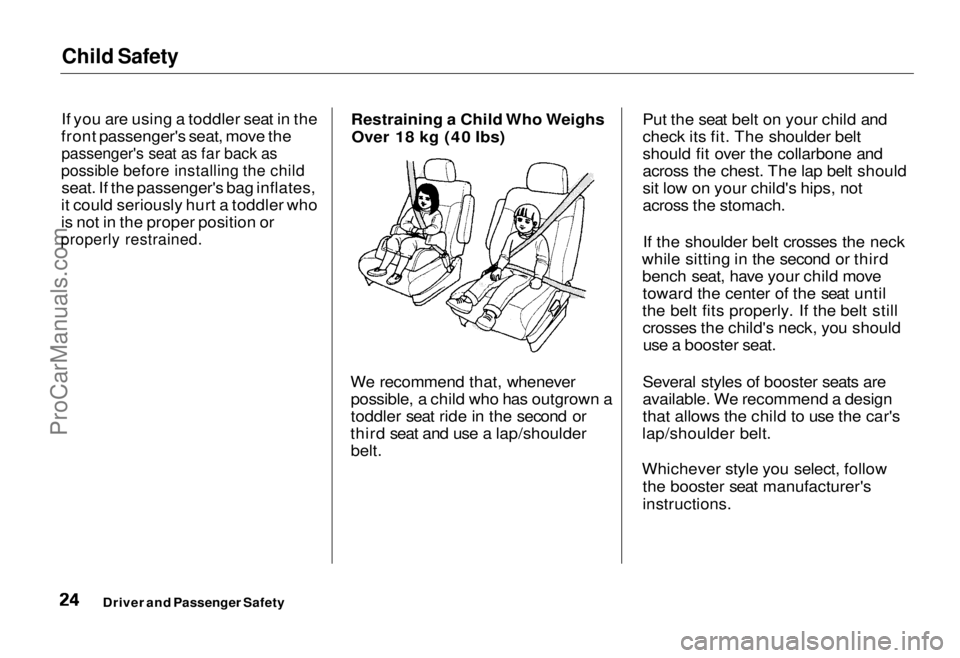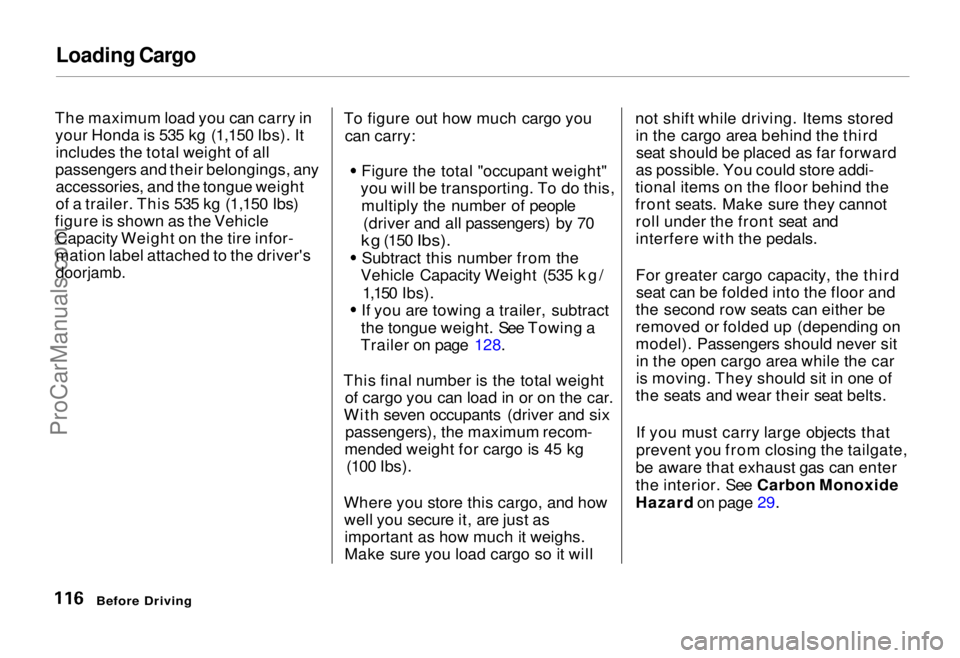1995 HONDA ODYSSEY tow
[x] Cancel search: towPage 1 of 240

Odyssey 1995 Online Reference Owner's Manual
Use these links (and links throughout this manual) to navigate through\
this reference.
For a printed owner's manual, click on authorized manuals or go to www.h\
elminc.com.
Contents
Introduction ........................................................................\
............................................................... i
A Few Words About Safety........................................................................\
....................................... ii
Driver and Passenger Safety ........................................................................\
.................................... 3
Proper use and care of your vehicle's seat belts, and Supplemental Restr\
aint System.
Instruments and Control s........................................................................\
........................................ . 33
Instrume nt panel indicator and gauge, and how to use dashboard and steering colu\
mn controls.
Comfort and Convenience Features ........................................................................\
..................... . 75
How to operate the climate control system, the audio system, and other c\
onvenience features.
Before Driving........................................................................\
..........................................................107
What gasoline to use, how to break -in your new vehicle, and how to load luggage and other cargo.
Driving ........................................................................\
......................................................................117
The proper way to start the engine, shift the transmission, and park, pl\
us towing a trailer.
Maintenance........................................................................\
.............................................................135
The Maintenance Schedule shows you when you need to take you r vehicle to the dealer.
Appearance Car e........................................................................\
..................................................... .183
Tips on cleaning and protecting your vehicle. Things to look for if your\
vehicle ever needs body repairs.
Taking Care of the Unexpecte d........................................................................\
..............................191
This section covers several problems motorists sometimes experience, an d how to handle them.
Technical Informatio n........................................................................\
.............................................215
ID numbers, dimensions, capacities, and technical information.
Warranty and Customer Relations (U.S. and Canada)................................................................227
A summary of the warranties covering your new Acura, and how to contact \
us.
Authorized Manu als (U.S. only)
........................................................................\
............................. .
233
How to order manuals and other technical literature.
Index ........................................................................\
........................ ...................................................... I
Service Information Summary
A summary of information you need when you pull up to the fuel pump.
Owner's Identification Form
ProCarManuals.com
Page 19 of 240

Additional Safety Information
The seat belts and airbags are obvi- ously important parts of your occu-
pant protection system.
In addition, you should know that sitting upright, adjusting the head
restraint properly, locking the doors, and stowing things properly can also
increase your safety and possibly even save your life. Seat-back Position
The seat-backs should be in an upright position for you and your
passengers to get the most protec-
tion from the seat belts.
If you recline a seat-back, you reduce
the protective capability of your seat
belt. The farther a seat-back is reclined, the greater the risk that
you will slide under the belt in a severe crash and be very seriously
injured.
For information on how to adjust the
seat-back, see page 57. Head Restraint Position
Head restraints can help protect you
from whiplash and other injuries. For the best protection, adjust the top of
the restraint so it is even with the
tops of your ears, or as high as possi-
ble. For instructions on adjusting the
head restraints, see page 58.
Driver and Passenger SafetyProCarManuals.comMain Menu Table of Contents s t
Page 25 of 240

Child Safety
If you are using a toddler seat in the
front passenger's seat, move the
passenger's seat as far back as
possible before installing the child
seat. If the passenger's bag inflates,
it could seriously hurt a toddler who
is not in the proper position or
properly restrained.
Restraining a Child Who Weighs
Over 18 kg (40 Ibs)
We recommend that, whenever possible, a child who has outgrown a
toddler seat ride in the second or
third seat and use a lap/shoulder
belt.
Put the seat belt on your child and
check its fit. The shoulder belt
should fit over the collarbone and
across the chest. The lap belt should
sit low on your child's hips, not
across the stomach.
If the shoulder belt crosses the neck
while sitting in the second or third bench seat, have your child movetoward the center of the seat until
the belt fits properly. If the belt still crosses the child's neck, you shoulduse a booster seat.
Several styles of booster seats are
available. We recommend a design
that allows the child to use the car's
lap/shoulder belt.
Whichever style you select, follow the booster seat manufacturer's
instructions.
Driver and Passenger SafetyProCarManuals.comMain Menu Table of Contents s t
Page 63 of 240

Seats
KNOB
3. Turn the knob on the back of the seat cushion while you pull the
entire seat towards you. Pivot the seat into the floor recess. To return the seat to the upright
position:
1. Pull the seat out of the recess by pulling on the handle. Pivot theseat forward all the way. KNOB
2. Turn the knob on the seat-back and pull the seat-back upright.
Make sure the seat is securely
locked in place.
3. Reinstall the head restraints.
Instruments and ControlsProCarManuals.comMain Menu Table of Contents s t
Page 79 of 240

Heating and Cooling
How to Use the System
This section covers the best way to use the system for ventilation,cooling, dehumidifying, defrosting
and heating. In most cases, the mode
and air source selections are only
recommendations. You may prefer different settings. Use mode to heat or cool the
interior more quickly, or to keep out
smoke and dust. Leaving the system
in the recirculation mode with the
A/C off can cause the windows to fog up. Switch to
mode as
soon as the interior reaches a
comfortable temperature or the
outside smoky, dusty condition
clears.
The engine must be running for the
heater and air conditioning to pro-
vide hot and cold air. The heater uses engine coolant to warm the air.If the engine is cold, it will be several
minutes before you feel warm air
circulating.
The air conditioning system does not depend on engine temperature. It
can produce cold air almost immedi-
ately.
Controlling Air Flow Direction
Air flows into the interior at three
levels: Toward the floor
through the dash vents and
toward the windshield and side
windows You select the air
flow level or combination of levels
with the five mode buttons.
Ventilation
Your car has a flow-through venti- lation system. Air enters the car
through vents in front of the wind-shield. It circulates through the
interior then exits through the rear side panels. This system provides
fresh air even when the car is standing still. To bring in outside air, press the button. Set the fan
at a comfortable speed.
CONTINUED
Comfort and Convenience FeaturesProCarManuals.comMain Menu Table of Contents s t
Page 107 of 240

Before Driving
Before you begin driving your Honda,
you should know what gasoline to use, and how to check the levels of
important fluids. You also need to
know how to properly stow luggage or packages. This section will help
you. If you plan to add any accesso- ries to your car, please read the
information in this section first. Break-in Period.............................. 108
Gasoline.......................................... 108 Oxygenated Fuels...................... 108
Driving in Foreign Countries... 109
Service Station Procedures .......... 110
Filling the Fuel Tank................. 110Opening the Hood..................... 111
Fuel Economy................................ 114
Vehicle Condition...................... 114Driving Habits............................ 114
Accessories..................................... 115 Loading Cargo................................ 116
Before DrivingProCarManuals.comMain Menu s t
Page 112 of 240

Service Station Procedures
Oil Check
Check the engine oil level every time
you fill the car with fuel. Wait at least two minutes after turning the engineoff before you check the oil.
1. Remove the dipstick (orange handle). 2. Wipe the dipstick with a clean
cloth or paper towel. 3. Insert it all the way back in its tube.
Before Driving
DIPSTICKProCarManuals.comMain Menu Table of Contents s t
Page 116 of 240

Loading Cargo
The maximum load you can carry in your Honda is 535 kg (1,150 Ibs). Itincludes the total weight of all
passengers and their belongings, any accessories, and the tongue weight
of a trailer. This 535 kg (1,150 Ibs)
figure is shown as the Vehicle Capacity Weight on the tire infor-
mation label attached to the driver's
doorjamb.
To figure out how much cargo you
can carry:
Figure the total "occupant weight"
you will be transporting. To do this,
multiply the number of people (driver and all passengers) by 70
kg
(150
Ibs).
Subtract this number from the
Vehicle Capacity Weight (535 kg/
1,150 Ibs).
If you are towing a trailer, subtract
the tongue weight. See Towing a
Trailer on page 128.
This final number is the total weight of cargo you can load in or on the car.
With seven occupants (driver and six
passengers), the maximum recom -
mended weight
for cargo is 45 kg
(100 Ibs).
Where you store this cargo, and how well you secure it, are just asimportant as how much it weighs.
Make sure you load cargo so it will not shift while driving. Items stored
in the cargo area behind the thirdseat should be placed as far forward
as possible. You could store addi-
tional items on the floor behind the
front seats. Make sure they cannot roll under the front seat and
interfere with the pedals.
For greater cargo capacity, the thirdseat can be folded into the floor and
the second row seats can either be
removed or folded up (depending on
model). Passengers should never sit in the open cargo area while the car
is moving. They should sit in one of
the seats and wear their seat belts.
If you must carry large objects that
prevent you from closing the tailgate,
be aware that exhaust gas can enter
the interior. See Carbon Monoxide
Hazard on page 29.
Before DrivingProCarManuals.comMain Menu Table of Contents s t